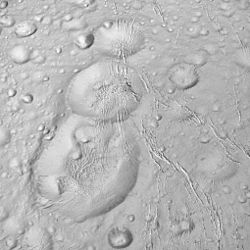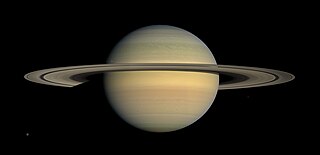
Saturn is the sixth planet from the Sun and the second-largest in the Solar System, after Jupiter. It is a gas giant with an average radius of about nine-and-a-half times that of Earth. It has only one-eighth the average density of Earth, but is over 95 times more massive. Even though Saturn is nearly the size of Jupiter, Saturn has less than one-third of Jupiter's mass. Saturn orbits the Sun at a distance of 9.59 AU (1,434 million km) with an orbital period of 29.45 years.

Titan is the largest moon of Saturn and the second-largest in the Solar System. It is the only moon known to have an atmosphere denser than the Earth's, and is the only known object in space other than Earth on which clear evidence of stable bodies of surface liquid has been found. Titan is one of the seven gravitationally rounded moons of Saturn and the second-most distant among them. Frequently described as a planet-like moon, Titan is 50% larger than Earth's Moon and 80% more massive. It is the second-largest moon in the Solar System after Jupiter's moon Ganymede, and is larger than Mercury, but only 40% as massive due to Mercury being made of mostly dense iron and rock, while a large portion of Titan is made of less-dense ice.

Rhea is the second-largest moon of Saturn and the ninth-largest moon in the Solar System, with a surface area that is comparable to the area of Australia. It is the smallest body in the Solar System for which precise measurements have confirmed a shape consistent with hydrostatic equilibrium. It was discovered in 1672 by Giovanni Domenico Cassini.

Helene is a moon of Saturn. It was discovered by Pierre Laques and Jean Lecacheux in 1980 from ground-based observations at Pic du Midi Observatory, and was designated S/1980 S 6. In 1988 it was officially named after Helen of Troy, who was the granddaughter of Cronus (Saturn) in Greek mythology. Helene is also designated Saturn XII (12), which it was given in 1982, and Dione B, because it is co-orbital with Dione and located in its leading Lagrangian point (L4). It is one of four known trojan moons.

Cassini–Huygens, commonly called Cassini, was a space-research mission by NASA, the European Space Agency (ESA), and the Italian Space Agency (ASI) to send a space probe to study the planet Saturn and its system, including its rings and natural satellites. The Flagship-class robotic spacecraft comprised both NASA's Cassini space probe and ESA's Huygens lander, which landed on Saturn's largest moon, Titan. Cassini was the fourth space probe to visit Saturn and the first to enter its orbit, where it stayed from 2004 to 2017. The two craft took their names from the astronomers Giovanni Cassini and Christiaan Huygens.

Tethys, or Saturn III, is the fifth-largest moon of Saturn, measuring about 1,060 km (660 mi) across. It was discovered by Giovanni Domenico Cassini in 1684, and is named after the titan Tethys of Greek mythology.

Dione, also designated Saturn IV, is the fourth-largest moon of Saturn. With a mean diameter of 1,123 km and a density of about 1.48 g/cm3, Dione is composed of an icy mantle and crust overlying a silicate rocky core, with rock and water ice roughly equal in mass. Its trailing hemisphere is marked by large cliffs and scarps called chasmata; the trailing hemisphere is also significantly darker compared to the leading hemisphere.

Enceladus is the sixth-largest moon of Saturn and the 19th-largest in the Solar System. It is about 500 kilometers in diameter, about a tenth of that of Saturn's largest moon, Titan. It is mostly covered by fresh, clean ice, making it one of the most reflective bodies of the Solar System. Consequently, its surface temperature at noon reaches only −198 °C, far colder than a light-absorbing body would be. Despite its small size, Enceladus has a wide variety of surface features, ranging from old, heavily cratered regions to young, tectonically deformed terrain.

Mimas, also designated Saturn I, is the seventh-largest natural satellite of Saturn. With a mean diameter of 396.4 kilometres or 246.3 miles, Mimas is the smallest astronomical body known to be roughly rounded in shape due to its own gravity. Mimas's low density, 1.15 g/cm3, indicates that it is composed mostly of water ice with only a small amount of rock, and study of Mimas's motion suggests that it may have a liquid ocean beneath its surface ice. The surface of Mimas is heavily cratered and shows little signs of recent geological activity. A notable feature of Mimas's surface is Herschel, one of the largest craters relative to the size of the parent body in the Solar System. Herschel measures 139 kilometres across, about one-third of Mimas's mean diameter, and formed from an extremely energetic impact event. The crater's name is derived from the discoverer of Mimas, William Herschel, in 1789. The moon's presence has created one of the largest 'gaps' in Saturn's ring, named the Cassini Division, due to orbital resonance destabilizing the particles' orbit there.

This article provides a timeline of the Cassini–Huygens mission. Cassini was a collaboration between the United States' NASA, the European Space Agency ("ESA"), and the Italian Space Agency ("ASI") to send a probe to study the Saturnian system, including the planet, its rings, and its natural satellites. The Flagship-class uncrewed robotic spacecraft comprised both NASA's Cassini probe, and ESA's Huygens lander which was designed to land on Saturn's largest moon, Titan. Cassini was the fourth space probe to visit Saturn and the first to enter its orbit. The craft were named after astronomers Giovanni Cassini and Christiaan Huygens.

The moons of Saturn are numerous and diverse, ranging from tiny moonlets only tens of meters across to the enormous Titan, which is larger than the planet Mercury. There are 146 moons with confirmed orbits, the most of any planet in the solar system. This number does not include the many thousands of moonlets embedded within Saturn's dense rings, nor hundreds of possible kilometer-sized distant moons that were seen through telescopes but not recaptured. Seven Saturnian moons are large enough to have collapsed into a relaxed, ellipsoidal shape, though only one or two of those, Titan and possibly Rhea, are currently in hydrostatic equilibrium. Three moons are particularly notable. Titan is the second-largest moon in the Solar System, with a nitrogen-rich Earth-like atmosphere and a landscape featuring river networks and hydrocarbon lakes. Enceladus emits jets of ice from its south-polar region and is covered in a deep layer of snow. Iapetus has contrasting black and white hemispheres as well as an extensive ridge of equatorial mountains among the tallest in the solar system.
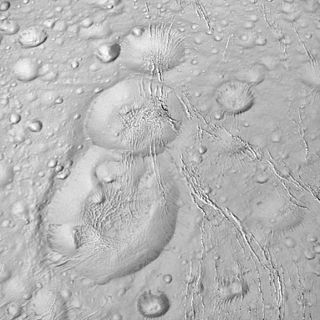
Shahrazad is a large crater on Saturn's moon Enceladus first discovered by the Voyager 2 spacecraft. It is located at 47.3° North Latitude, 199.7° West Longitude and is approximately 20 kilometers across. Shahrazad is the middle crater of a prominent crater triplet on Enceladus' anti-Saturnian hemisphere. Voyager images revealed very little about this crater, however, higher resolution views of Shahrazad taken by the Cassini Spacecraft during a close flyby on March 9, 2005, reveal significant north–south fracturing that runs through all three craters of the triplet. Deep canyons mark the northern and eastern portions of Shahrazad's rim. Some evidence for viscous relaxation can be seen, but it is not nearly as significant as at Dunyazad to its immediate south or at Aladdin elsewhere on the satellite.
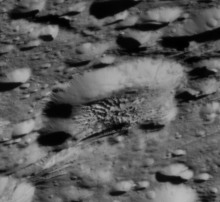
Dalilah is a crater in the northern hemisphere of Saturn's moon Enceladus. Dalilah was first discovered in Voyager 2 images but was seen at much higher resolution by Cassini. It is located at 51.89°N 248.54°W and is 16 kilometers across. Fractures have deformed the south-eastern side of Dalilah as well as the dome at the center of the crater. This tectonic deformation was formed through viscous relaxation. Similar deformation is also seen on a slightly larger scale at Dunyazad crater.
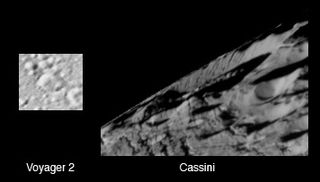
Duban is a crater in the northern hemisphere of Saturn's moon Enceladus. Duban was first seen in Voyager 2 images, though the crater has also been seen in much higher resolution Cassini images. It is located at 58.38°N 282.91°W and is 19 kilometers across. In the Cassini image, evidence for significant tectonic deformation can be seen along the northwest rim of the crater.

Shahryar is a crater in the northern hemisphere of Saturn's moon Enceladus. Shahryar was first seen in Voyager 2 images, but was seen at much higher resolution by the Cassini spacecraft. It is located at 58.3° North Latitude, 227.5° West Longitude and is 24 kilometres (15 mi) across. Despite being nearly the same size as the nearby Sindbad crater, Shahryar does not exhibit a dome-like structure on its floor, suggesting it has not undergone significant viscous relaxation. In addition, there is very little evidence that it has experienced tectonic deformation, suggesting that Shahryar is a relatively young crater.
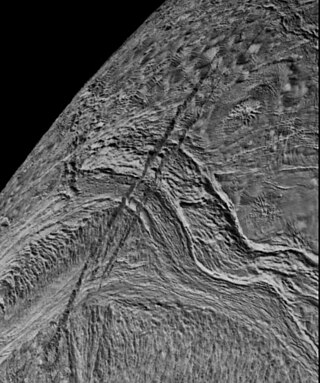
Harran Sulci is a region of grooved terrain on the surface of Saturn's moon Enceladus. The feature is centered at 26.7° North Latitude, 237.6° West Longitude and is approximately 276 kilometers long. Harran Sulci bounds Diyar Planitia to the north and east.

The tiger stripes of Enceladus consist of four sub-parallel, linear depressions in the south polar region of the Saturnian moon. First observed on May 20, 2005, by the Cassini spacecraft's Imaging Science Sub-system (ISS) camera, the features are most notable in lower resolution images by their brightness contrast from the surrounding terrain. Higher resolution observations were obtained by Cassini's various instruments during a close flyby of Enceladus on July 14, 2005. These observations revealed the tiger stripes to be low ridges with a central fracture. Observations from the Composite Infrared Spectrometer (CIRS) instrument showed the tiger stripes to have elevated surface temperatures, indicative of present-day cryovolcanism on Enceladus centered on the tiger stripes.

Al-Haddar is an impact crater on Saturn's moon Enceladus, first discovered by the Voyager spacecraft. It is named after Al-Haddar, one of the barber's six brothers in "The Hunchback's Tale" from The Book of One Thousand and One Nights.

Zumurrud is a large impact crater on the anti-Saturn hemisphere of Saturn's moon Enceladus. Zumurrud was first observed in Cassini images during that mission's March 2005 flyby of Enceladus. It is located at 21.9° South Latitude, 181.6° West Longitude, and is 21 kilometers across. Images taken by Cassini during its March and July 2005 flybys of Enceladus revealed a great deal about the geology of this impact crater. Since formation, Zumurrud has been modified by viscous relaxation, tectonic fracturing along the crater's rim, forming canyons hundreds of meters deep, and subsequent cratering, like the small crater along Zumurrud's western rim. In addition, brightness variations can be seen along the eastern crater wall, suggesting variations in water ice grain size.
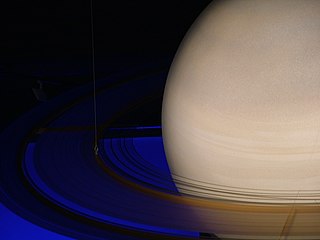
The exploration of Saturn has been solely performed by crewless probes. Three missions were flybys, which formed an extended foundation of knowledge about the system. The Cassini–Huygens spacecraft, launched in 1997, was in orbit from 2004 to 2017.
